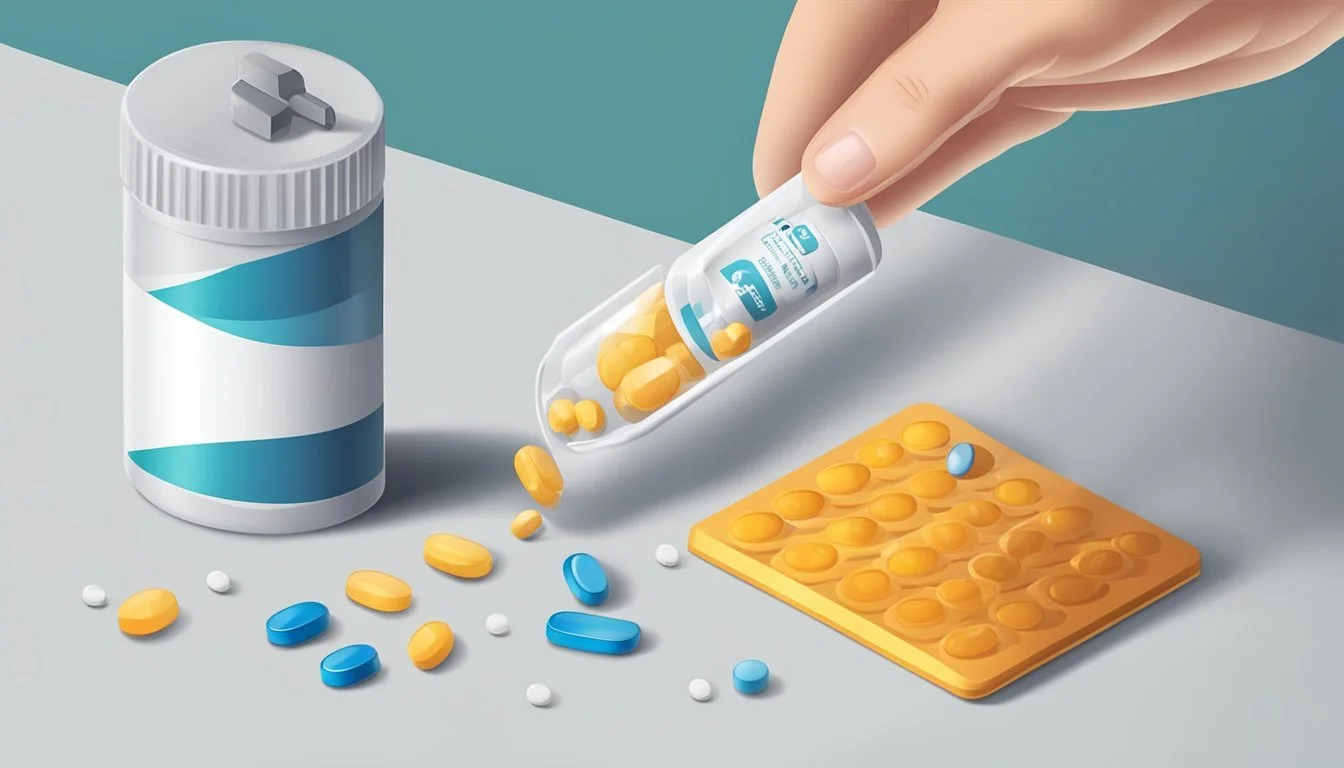Managing Impulsivity with Guanfacine Treatment
Guanfacine, a medication originally developed to treat high blood pressure, has found a new purpose in managing impulsivity associated with attention-deficit/hyperactivity disorder (ADHD). This non-stimulant drug works by enhancing prefrontal cortical regulation of attention and impulse control, effectively strengthening the brain's ability to manage impulsive behaviors.
The prefrontal cortex plays a crucial role in controlling impulsivity and attention span. Guanfacine's action on this specific brain area makes it a valuable option for individuals struggling with ADHD symptoms, particularly those related to impulsive actions and decisions.
While stimulant medications are often the first-line treatment for ADHD, guanfacine offers an alternative approach. It can be used alone or in combination with other treatments to address impulsivity and inattention. Some individuals may experience improvements in symptoms within days of starting guanfacine, though it may take longer for the full effects to become apparent.
Understanding Impulsivity and ADHD
Impulsivity is a core feature of Attention-Deficit/Hyperactivity Disorder (ADHD) that significantly impacts daily functioning. It manifests as quick, unplanned reactions without considering potential consequences.
Defining Impulsivity and Its Role in ADHD
Impulsivity in ADHD involves difficulty controlling immediate reactions and urges. It often results in hasty actions that occur without forethought and have high potential for harm.
The prefrontal cortex, responsible for impulse control, functions differently in individuals with ADHD. This leads to challenges in stopping and thinking before acting.
Common impulsive behaviors in ADHD include:
Interrupting others
Making important decisions without careful consideration
Engaging in risky activities
Difficulty waiting one's turn
Impulsivity interacts closely with other ADHD symptoms like inattention and hyperactivity, exacerbating overall difficulties.
Prevalence and Impact on Individuals
ADHD affects approximately 5% of children worldwide, with impulsivity being a key component for many. These impulsive tendencies often persist into adulthood.
Impulsivity can negatively impact various life areas:
Academic performance
Social relationships
Job stability
Financial management
Personal safety
Children with ADHD may struggle with peer relationships due to impulsive behaviors like interrupting or acting without thinking. This can lead to social isolation or rejection.
Adults may face challenges in the workplace, such as difficulty following procedures or making rash decisions. Impulsive spending or risky driving behaviors are also common concerns.
Early identification and appropriate management of impulsivity in ADHD are crucial for improving long-term outcomes and quality of life.
Guanfacine as a Treatment Option
Guanfacine is a medication that has shown promise in managing impulsivity and other symptoms associated with attention deficit hyperactivity disorder (ADHD). It offers a non-stimulant approach to treatment, working through a unique mechanism of action.
Guanfacine Overview and Usage
Guanfacine is available in two formulations: immediate-release (Tenex) and extended-release (Intuniv). The FDA has approved guanfacine for treating ADHD in children and adolescents aged 6-17 years.
Doctors may prescribe guanfacine as a monotherapy or in combination with stimulant medications. The typical starting dose is 1 mg once daily, which can be adjusted based on individual response and tolerability.
Guanfacine is particularly useful for patients who cannot tolerate stimulants or have not responded adequately to other ADHD treatments. It may also benefit those with comorbid conditions such as oppositional defiant disorder or conduct disorder.
Mechanism of Action
Guanfacine functions as an alpha-2a adrenergic receptor agonist. It selectively binds to and activates alpha-2a receptors in the prefrontal cortex, an area crucial for executive functions and impulse control.
This activation enhances norepinephrine signaling, which is believed to improve attention, working memory, and behavioral inhibition. By modulating prefrontal cortex activity, guanfacine helps reduce impulsivity and hyperactivity.
Unlike stimulants, guanfacine does not increase dopamine levels in the brain's reward centers. This unique mechanism may result in a lower potential for abuse and different side effect profile compared to stimulant medications.
Efficacy and Effectiveness
Clinical studies have demonstrated guanfacine's efficacy in reducing ADHD symptoms, including impulsivity. A meta-analysis of randomized controlled trials found that guanfacine significantly improved ADHD rating scale scores compared to placebo.
Guanfacine has shown particular effectiveness in managing hyperactivity and impulsivity symptoms. Some studies suggest it may be more beneficial for the hyperactive-impulsive and combined subtypes of ADHD than for predominantly inattentive type.
The medication's effects are generally observed within 1-2 weeks of starting treatment, with full benefits often seen after 4-8 weeks. Long-term studies have shown that guanfacine can maintain its effectiveness for up to two years of continuous use.
Guanfacine's non-stimulant nature makes it a valuable option for patients with a history of substance abuse or those at risk for stimulant misuse. It also offers a longer duration of action compared to some stimulant medications, potentially providing more consistent symptom control throughout the day.
Clinical Research and Trials
Guanfacine has been extensively studied for its effects on impulsivity in attention deficit hyperactivity disorder (ADHD). Multiple placebo-controlled trials have demonstrated its efficacy, particularly in pediatric populations.
Review of Key Studies
J Am Acad Child Adolesc Psychiatry published several influential studies on guanfacine for impulsivity. Biederman J et al. conducted a randomized trial with 345 children aged 6-17, finding significant improvements in ADHD symptoms.
Another study in Pediatrics examined 338 participants, revealing guanfacine's positive impact on impulse control. The drug showed a favorable safety profile compared to stimulants.
A meta-analysis of 7 trials, available on PubMed, concluded guanfacine was superior to placebo for reducing impulsivity in ADHD patients.
Placebo-Controlled Trials
A double-blind, placebo-controlled study of 324 children with ADHD found guanfacine significantly reduced impulsive behaviors. 67% of patients on guanfacine showed improvement versus 44% on placebo.
Another 8-week trial compared guanfacine to placebo in 217 adults with ADHD. Results indicated a 30% reduction in impulsivity scores for the guanfacine group compared to 17% for placebo.
A multicenter study of 461 participants aged 6-17 demonstrated guanfacine's efficacy in treating impulsivity across different age groups and ADHD subtypes.
Safety Profile and Side Effects
Guanfacine's safety profile is generally favorable, but it can cause various side effects that require careful monitoring. Proper management and consideration of individual patient factors are essential for safe and effective use.
Common Adverse Events
Guanfacine may cause several common side effects. Drowsiness and fatigue are frequently reported, affecting daily activities. Dry mouth is another common complaint. Some patients experience dizziness, particularly when changing positions.
Headaches and stomach discomfort occur in some cases. Weight gain has been noted, though it's typically mild. Blood pressure and heart rate changes are important to monitor, as guanfacine can cause decreases in both.
Less frequent side effects include constipation and mild cognitive effects like difficulty concentrating. These adverse events often diminish over time as the body adjusts to the medication.
Managing Side Effects
Proper dose titration is crucial for minimizing side effects. Starting with a low dose and gradually increasing can help reduce adverse events. Taking guanfacine at bedtime may alleviate daytime drowsiness.
For dry mouth, staying hydrated and using sugar-free gum or lozenges can provide relief. To manage dizziness, patients should rise slowly from sitting or lying positions.
Regular blood pressure and heart rate monitoring is essential. If significant changes occur, dose adjustments may be necessary. Weight should be tracked, with dietary modifications implemented if needed.
Patients should avoid alcohol while taking guanfacine, as it can exacerbate side effects. Open communication with healthcare providers allows for prompt addressing of any concerns.
Considerations for Special Populations
Elderly patients may be more sensitive to guanfacine's effects on blood pressure and heart rate. Lower starting doses and more frequent monitoring are often necessary.
In patients with heart disease or hypertension, careful cardiovascular assessment is crucial before initiating treatment. Regular ECG monitoring may be warranted in these cases.
Guanfacine should be used cautiously in individuals with a history of fainting or substance use disorders. Pregnancy and breastfeeding require special consideration, weighing potential risks and benefits.
Children and adolescents may experience different side effect profiles compared to adults. Growth and development should be closely monitored in younger patients taking guanfacine long-term.
Dosage and Administration
Guanfacine dosing for impulsivity requires careful consideration of individual patient factors. Proper administration and dose adjustments are crucial for achieving optimal therapeutic effects while minimizing side effects.
Recommended Dosages and Schedules
Guanfacine is typically initiated at 1 mg once daily for children and adolescents. The dose may be increased by 1 mg weekly, up to a maximum of 4 mg daily. Adults usually start with 1 mg daily, with potential increases to 2-3 mg daily.
Extended-release tablets are taken once daily, preferably in the morning. They should be swallowed whole with water, not chewed or crushed.
Dosing is based on body weight in some cases:
0.05-0.08 mg/kg/day for children 6-12 years
0.04-0.07 mg/kg/day for adolescents 13-17 years
Consistency in timing and food intake with doses is important for maintaining steady blood levels.
Adjustments for Efficacy and Tolerance
Dose adjustments may be necessary to balance efficacy and side effects. Increases should occur gradually, no more frequently than weekly.
If switching from immediate-release to extended-release formulations, use the same total daily dose. Monitor for changes in effectiveness or side effects.
Certain medications can affect guanfacine levels:
Ketoconazole may increase levels; reduce guanfacine dose by 50%
Rifampin may decrease levels; consider dose increases
Discontinuation should involve gradual dose reduction to avoid rebound hypertension. Taper by no more than 1 mg every 3 to 7 days.
In cases of missed doses, take the missed dose as soon as remembered, unless it's close to the next scheduled dose. Never take double doses.
Comparative Analysis
Guanfacine has shown efficacy for treating impulsivity in ADHD, but its effects differ from other medications. Comparing guanfacine to stimulants and nonstimulant alternatives reveals important distinctions in mechanism, efficacy, and side effects.
Guanfacine vs. Stimulant Medications
Guanfacine acts as an α2A-adrenergic receptor agonist, while stimulants like methylphenidate and amphetamine primarily affect dopamine. Stimulants tend to have a faster onset of action and stronger effects on core ADHD symptoms. However, guanfacine may be preferable for patients with anxiety or tic disorders.
Guanfacine has a lower risk of abuse potential compared to stimulants. It also causes less insomnia and appetite suppression. Stimulants generally show greater efficacy for improving attention, but guanfacine may be superior for reducing impulsivity and aggression in some patients.
Guanfacine vs. Nonstimulant Alternatives
The main nonstimulant alternatives to guanfacine are atomoxetine and clonidine. Atomoxetine is a norepinephrine reuptake inhibitor, while clonidine is another α2-adrenergic agonist.
Guanfacine tends to cause less sedation than clonidine. It may also have stronger effects on working memory and impulse control. Compared to atomoxetine, guanfacine has a quicker onset of action but requires more frequent dosing.
All three medications can improve impulsivity, but their side effect profiles differ. Guanfacine is less likely to cause nausea or sexual side effects than atomoxetine. However, it may lead to more dizziness and fatigue in some patients.
Additional Considerations
Guanfacine treatment for impulsivity involves more than just medication. Behavioral therapies, caregiver support, and long-term management are crucial components for optimal outcomes.
Combination with Behavioral Therapies
Combining guanfacine with behavioral therapies can enhance its effectiveness in managing impulsivity. Cognitive-behavioral therapy (CBT) helps children and youth develop coping strategies and impulse control techniques. Parent training programs teach caregivers how to reinforce positive behaviors and manage challenging situations.
Animal models suggest that guanfacine's mechanism of action in the striatum may complement behavioral interventions. This combination approach targets both neurochemical imbalances and learned behaviors.
Integrating medication and therapy allows for personalized treatment plans. Some patients may require lower doses of guanfacine when used alongside behavioral strategies.
The Role of Caregivers and Educators
Caregivers and educators play a vital role in supporting individuals taking guanfacine for impulsivity. Parents and teachers should monitor for adverse effects such as:
Lethargy
Insomnia
Dizziness
Decreased appetite
Constipation
Consistent communication between caregivers, educators, and healthcare providers is essential. This collaboration helps identify any needed dosage adjustments or additional interventions.
Educators can implement classroom strategies to support impulse control. These may include:
Structured environments
Clear expectations
Positive reinforcement techniques
Long-term Management and Prognosis
Long-term management of impulsivity with guanfacine requires ongoing assessment and adjustment. Regular follow-ups with healthcare providers are crucial to monitor progress and address any concerns.
The half-life of guanfacine allows for once-daily dosing, which can improve adherence. However, abrupt discontinuation should be avoided to prevent potential rebound effects.
Long-term prognosis varies among individuals. Some may require continued medication, while others may transition to behavioral strategies alone. Factors influencing prognosis include:
Age of treatment initiation
Severity of impulsivity
Presence of comorbid conditions
Consistency of treatment adherence
Substance abuse risk should be monitored, especially in adolescents and young adults. Guanfacine is not associated with abuse potential, unlike some other medications used for impulse control.
Impact on Society and Healthcare
Guanfacine's use for impulsivity has significant implications for individuals, healthcare systems, and society at large. Its effectiveness in managing ADHD symptoms affects economic costs, social dynamics, and support networks.
Economic and Social Costs
ADHD imposes substantial economic burdens on healthcare systems and society. The disorder's prevalence, estimated at 5-7% in children and 2.5% in adults, leads to increased healthcare utilization and costs. Impulsivity-related injuries and accidents contribute to these expenses.
Studies suggest that ADHD treatment, including medications like guanfacine, can reduce overall healthcare costs. Improved symptom management often results in fewer emergency room visits and hospitalizations.
Socially, untreated impulsivity can lead to difficulties in education, employment, and relationships. Effective treatment with guanfacine may improve academic performance, workplace productivity, and social interactions.
Advocacy and Support Networks
ADHD advocacy groups play a crucial role in raising awareness about impulsivity and available treatments. These organizations provide valuable resources for patients and families navigating the complexities of ADHD management.
Support networks often offer:
Educational workshops
Peer support groups
Information on treatment options, including guanfacine
These networks also advocate for improved access to medications and therapies. They work to reduce stigma associated with ADHD and impulsivity, promoting understanding and acceptance in schools, workplaces, and communities.
Collaboration between healthcare providers, patients, and advocacy groups has led to more comprehensive ADHD management strategies. This partnership enhances the effectiveness of treatments like guanfacine by addressing both medical and social aspects of impulsivity.






